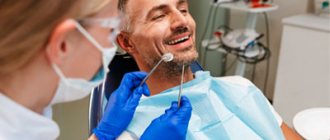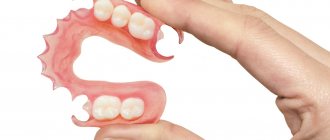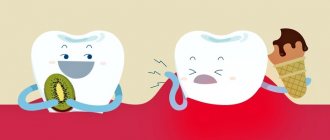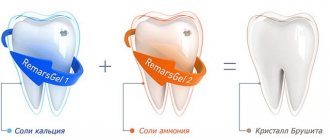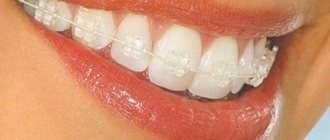- home
- Dental news
- Teeth filing
|
|
A unique teeth filing procedure has been used to create a perfect smile since 200 years ago. At that time, such a unique treatment was used to prevent caries by completely removing damaged hard tissues. Now the technology is actively used in dentistry to eliminate aesthetic defects and straighten teeth.
Filing is recommended for patients whose one or more teeth differ in size or stand out from the general row. A popular indication for the procedure is the presence of small chips on the fangs or incisors.
What is an impacted tooth?
Retention is an abnormality in tooth eruption, in which the tooth erupts partially or remains completely in the tissues of the jaw.
An impacted tooth is a tooth that has failed to erupt and “sleeps” in the gum or even in the jaw bone. There are cases when only part of the tooth crown erupts and is visible, and the rest of the tooth is covered by the gum - such teeth are called semi-impacted.
Most often, impacted canines and wisdom teeth are found - the notorious eights, but there are cases of impaction of the central and lateral incisors, and the first - a little more often.
What are the types of tooth impaction?
There are two types of retention - partial, in which part of the tooth is visible from the gums, and complete - in which the tooth is completely located under the gum tissue and/or jaw bone.
Such teeth can also be positioned differently, both being in “their” place in the dentition and occupying an incorrect position outside the dentition.
- Vertical
- Horizontally.
- At an angle to the jaw
If a tooth does not erupt in the right place beyond the border of the dentition, they speak of tooth dystopia.
There are even reverse retentions, when the tooth lies “upside down,” that is, upside down with its roots.
There may be only one impacted tooth in the dentition, or two impacted teeth may be located symmetrically. This problem concerns both milk and permanent teeth.
What complications do impacted teeth cause and why do they need to be “extracted”?
It is difficult for the patient to immediately understand what danger “hidden” teeth can pose, but it is really serious.
Semi-retinated teeth cause inflammation of the “hood” with which they are covered and adjacent tissues, and this provokes purulent inflammation.
Fully impacted teeth that lie in the jaw can behave like a foreign body; they put pressure on neighboring teeth, causing their displacement and a number of other problems.
In this case, the patient experiences pain and fever in case of inflammation, a feeling of pressure and discomfort in the jaw, neuralgia or numbness of part of the face.
If we list the diseases that can result from impacted teeth, it will become clear that this is a real “time bomb” that can detonate at any moment.
What diseases can be caused by an impacted tooth:
- periodontal cyst,
- caries of neighboring teeth and their roots,
- pulpitis,
- pericoronitis,
- periostitis,
- periodontitis,
- purulent lymphadenitis,
- inflammation of the trigeminal nerve,
- odontogenic sinusitis,
- abscess,
- phlegmon,
- resorption (resorption) of the roots of adjacent teeth,
- bad habits: mouth breathing, infantile swallowing, inserting the tongue into a dental defect,
- problems with biting food,
- malocclusion, displacement of interdental contacts, crowding of teeth.
How are impacted teeth diagnosed?
Impacted teeth are often “found” by accident during an X-ray diagnosis for another dental reason. If a patient asks about orthodontic treatment and is missing some teeth, or has symptoms that may be caused precisely by the presence of hidden impacted teeth, then a special diagnosis is carried out.
The problem of impacted teeth is solved by two specialized dentists - an orthodontist and a surgeon, so the patient will have to undergo diagnostics by an orthodontist and diagnostics by a surgeon. Most of the diagnostic procedures will be general, and the key is x-ray diagnostics, and it is preferable to do CT - computed tomography (3D diagnostics). Unlike an orthopantomogram (OPTG), it shows the spatial location of the impacted tooth in the jaw and relative to other teeth, which is very important for the surgical stage of traction - exposing its crown, because allows the surgeon to choose the optimal “approach”.
Veneers and teeth grinding are the main problems
Veneers are thin plates of ceramic or reflective composite materials used to correct the shape or color of teeth. Microprostheses have many advantages - high aesthetics, durability and reliability. But at the same time, the overlays have a significant drawback, which often becomes a reason for patients to refuse the procedure. We are talking about such an important stage as preparing the tooth before installing veneers.
Interesting fact!
Veneers were first invented in America in the 30s of the twentieth century. At first they were made to order for Hollywood stars, so that they would shine not only with their talents, but also with their perfect, dazzling smiles. However, at that time they were glued to the teeth for only a few days with a special adhesive mixture. Compared to modern orthopedic designs, these were primitive and crude onlays for quick correction of teeth during filming.
What to do if an impacted tooth is found?
There are 3 solutions to the problem of an impacted tooth:
- Orthodontic traction and placement in the dentition. This is often done with impacted teeth that are located in the smile zone - canines and incisors, provided that there is a place for them in the dentition and the tooth itself is healthy.
- Removal is a common fate for impacted eights, especially if the patient is undergoing orthodontic treatment. Very often, wisdom teeth erupt partially – this provokes inflammation and complications. Even a completely impacted (“hidden”) tooth serves as a potential source of caries, tooth displacement, and instability of orthodontic treatment. There are many reasons - there is only one verdict: it is better to delete it. Other indications for the removal of different types of impacted teeth are cysts, signs of inflammation, lack of space in the dentition, destruction of the neck of the tooth, caries.
- Preservation and surveillance. It is justified when the patient has no problems with the place in the dentition or bite, orthodontic treatment is not required, the tooth does not provoke complications and its absence does not spoil the aesthetics of the smile. Such teeth are observed; in case of the slightest problem, they are recommended to be removed.
Disadvantages of installing veneers without grinding
- ✔
If the tooth is not prepared before fixing the ceramic plate, then its surface is necessarily treated with a special acid, which irreversibly changes the color of the enamel to such an extent that it will not be possible to do without veneers in the future.
✔
Too thin lumineers, which do not require grinding of the teeth, are not able to effectively hide significant defects in the shape of the teeth.
✔
Thin veneers without grinding make teeth visually thicker, which negatively affects their aesthetics.
✔
Grinding allows you to create a correct and smooth transition of the veneer into the tooth tissue. Installing veneers without grinding the teeth can cause plaque accumulation, gum inflammation and the formation of caries in the cervical area.
How to pull out and place an impacted tooth in the dentition?
In some cases, if the root of an impacted tooth has not yet formed and there is an obstacle to its eruption, then removing such an obstacle is enough for the tooth to come out of the gums and take its place in the dentition. If the tooth root is already formed, this method will not help.
To “get” and move a fully formed impacted tooth into the dentition, treatment is carried out in 3 stages. Here we present the “classical” scheme, because in individual cases there may be deviations from this scheme.
- Preparatory orthodontic stage - you need to prepare a place in the dentition to which the orthodontist will move the extracted tooth. To do this, a braces system is installed, which aligns the teeth in the dentition and frees up the necessary space.
- The surgical stage is the image of the crown of an impacted tooth, on which a bracket or button is installed to transmit force from an arch or elastic element.
- The main orthodontic stage, during which the impacted tooth is pulled out and placed in its “rightful” place in the dentition.
Veneers with minimal grinding of teeth
The thinner the veneer, the less you need to grind off the enamel before installing a microprosthesis. The table below will help you compare the characteristics of different types of structures and choose the best option with the least grinding of teeth and optimal cost.
Composite veneers
Manufacturing type:
Formed immediately in the patient’s oral cavity
Thickness:
0.3 - 0.6 mm
Turning:
No
Price in Moscow:
from 5,000 rub.
- Speed of production.
- Installation without grinding teeth.
- Acceptable price.
- Short service life.
- Variability of color.
- Fragility.
- Insufficient aesthetics.
- Poor ability to hide dental defects.
Ceramic veneers
Manufacturing type:
Produced in a dental laboratory
Thickness:
0.5 mm
Turning:
Yes
Price in Moscow:
from 14,000 rub.
- Aesthetics.
- Reliability.
- Color constancy.
- Durability.
- High price.
- Irreversibility of turning a tooth under a ceramic veneer.
- Long production time.
Zirconium veneers
Manufacturing type:
Produced in a dental laboratory
Thickness:
0.5 - 0.7 mm
Turning:
Yes
Price in Moscow:
from 17,000 rub.
- Aesthetics.
- Durability.
- Strength.
- High price.
How is surgery performed to expose the crown of an impacted tooth?
- As a preliminary stage, preparation for the operation is carried out. The patient undergoes professional hygiene and sanitation to reduce the amount of infection in the oral cavity and speed up postoperative healing.
- The operation to expose an impacted tooth is performed under local infiltration anesthesia and is considered a fairly serious surgical intervention.
The operation to expose the crown of an impacted tooth and install an orthodontic element on it can be carried out according to 2 schemes:
I Delayed bracket installation.
- The mucous membrane in the projection of the crown of the impacted tooth is excised, the entire crown of the tooth is exposed, and a special tampon is installed in the wound.
- After 2-3 days, a button or bracket is installed on the crown of the exposed tooth, which is tied to the orthodontic arch and traction begins.
II Bracket installation during surgery
- The dentist-surgeon peels off a small mucoperiosteal flap and exposes part of the crown of the impacted tooth, onto which the locking element is immediately fixed.
- The bracket is tied to an orthodontic arch or additional devices.
- After installing the orthodontic element, the flap of tissue is placed in place and the wound is sutured.
The disadvantage of this method is that in this case, repeated surgical intervention is possible if the bracket on the tooth comes off.
After surgery, the patient is prescribed antibiotics and antiseptic rinses, if necessary, to speed up healing. Light, non-traumatic food is recommended.
Stages of the procedure
Artistic restoration of fangs is not complete without a complex of preparatory therapy and preventive measures. Preparation can be divided into 2 types of procedures – general preparatory and direct mandatory. The first are carried out at the request of the patient and if there are indications, and the second represent a preliminary part of the restoration of tooth tissue. The dentist pays attention to the condition of the oral cavity, dental tissue and gums.
Professional scaling, plaque removal, and cavity treatment may be necessary before fangs can be made. Then an impression of the future canine is made. Using an impression, the appropriate shape and size are determined.
READ ALSO: How is fang removal surgery performed?
An important stage in growing fangs is preparation. This procedure, which involves removing (grinding) the surface dental tissues, is necessary for high-quality adhesion of the composite to natural tissue. Preparation requires extreme caution: the doctor must sharpen the structure so as not to injure the deep layers of bone tissue.
The listed methods have obvious advantages over implantation and prosthetics. Extension is actively practiced in pediatric dentistry.



